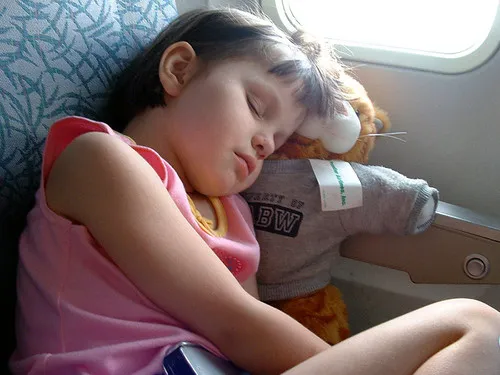Embarking on a long flight can be exciting, but it often comes with a challenge. How to sleep on a plane? You know that you should, but is it even possible to get a good rest on a plane? This article provides practical tips and tricks to help you sleep better during long-haul flights, ensuring you arrive at your destination feeling refreshed and ready to explore.
Understanding Sleep on a Plane
Why Sleep is Important During Flights
Getting enough restful sleep during a long flight is crucial for combating jet lag and maintaining your sleep schedule. When you’re able to sleep on an airplane, you’re more likely to feel energized upon arrival and can adapt more quickly to the new time zone. Prioritizing quality sleep can significantly impact your overall travel experience, making it easier to enjoy your destination from the moment you land.
Challenges of Sleeping on an Airplane
Several factors contribute to the difficulty of trying to sleep on a plane. The upright position of an airplane seat can make it difficult to sleep, and plane noise, light, turbulence, and cabin air all make sleeping on a plane more challenging than sleeping at home. The discomfort of airplane seats can lead to back pain, making it even harder to fall asleep and maintain quality sleep. The in-flight environment presents unique obstacles that require strategic solutions.
Factors Affecting Sleep on Long Flights
Numerous elements can influence your ability to actually sleep during long-haul flights. These factors collectively determine how easily you fall asleep and the quality of sleep you get. Some of these factors are:
| Factor | Effect on Sleep |
|---|---|
| Dehydration | Can disrupt your sleep. |
| Flight Timing | Can impact your circadian rhythm. |
Furthermore, the type of seat you have affects your comfort and ability to block out light and noise.
Tips for Sleeping on a Long Flight
Choosing the Right Seat: Window vs. Middle Seat
A window seat is often recommended because it provides a surface to lean against. Also, you won’t have to worry about other passengers needing to get up and disturbing you. For other travelers, an aisle seat might be a better option depending on their needs, as described in the table below. Many airlines allow seat selection in advance, and paying a little extra can ensure you get your preferred seat.
| Seat Type | Benefit |
|---|---|
| Aisle | Easy access to the aisle, good for frequent bathroom trips. |
| Window | Surface to lean against, less likely to be disturbed by other passengers. |
Essential Items: Neck Pillow and Travel Pillow
While a neck pillow might seem cumbersome, it’s an essential item for improving sleep quality during a long flight. Investing in a quality neck pillow is a worthwhile decision for any frequent traveler looking to improve their in-flight sleep.
| Benefit | Feature |
|---|---|
| Prevents neck and back pain | Provides support |
| Space-saving | Compact and discreet models available |
Creating a Comfortable Environment: Eye Mask and Earplugs
Creating a comfortable environment is key to trying to sleep on a plane. An eye mask and earplugs are essential items for blocking out disruptive stimuli. The eye mask can block out light from windows or overhead lights, while earplugs or noise-canceling headphones can help block out background cabin noise and other passengers. Limiting these distractions makes it easier to fall asleep. These sleep aids can significantly enhance sleep quality, ensuring you arrive at your destination well-rested after your long-haul flight.
Techniques to Actually Sleep on a Plane
Establishing a Bedtime Routine
To improve your chances of sleeping on a plane, establishing a bedtime routine can be very effective. Mimicking your normal nighttime habits, even in a simplified manner, can signal to your body that it’s time for shut-eye. This could involve changing into comfortable clothes, brushing your teeth, or applying a soothing lotion. By creating a familiar pre-sleep environment, you can help yourself fall asleep more easily and enhance your sleep quality on the long-haul flight.
Using Sleep Aids: Sleeping Pills and Natural Remedies
While the idea of using sleep aids, such as sleeping pills or melatonin, might seem appealing for a long flight, it’s important to approach them with caution. Before using any sleep medicine, it’s best to consult with a healthcare professional. Even over-the-counter sleep aids can have side effects. Trying out any sleep aid at home before your flight is a prudent step. Natural remedies, such as herbal teas, may offer a gentler alternative to help you fall asleep.
Hydration and the Impact of Alcohol and Caffeine
Staying properly hydrated is crucial for maintaining sleep quality. Cabin air is notoriously dry, leading to dehydration. Avoid excessive alcohol and caffeine, as they can disrupt your sleep schedule and worsen dehydration, making it harder to fall asleep. Opt for water or herbal teas to help you stay hydrated and relaxed. Proper hydration minimizes jet lag. Staying hydrated helps regulate your body’s functions, improving your overall ability to achieve restful sleep.
Managing Jet Lag and Time Zone Changes
Adjusting Your Sleep Schedule Before Travel
One of the best tips for how to sleep and minimize jet lag is to adjust your sleep schedule gradually before your flight. Shifting your bedtime earlier or later, depending on your destination’s time zone, can help your circadian rhythm adapt more smoothly. Start adjusting your sleep schedule a few days before departure to ease the transition. Set your watch to the destination time as soon as you board the airplane. This will allow you to sleep better, and you can also mentally prepare for the new time zone.
Tips for Napping During Your Flight
Strategic napping during your long-haul flight can significantly reduce the effects of jet lag. Plan your naps to align with the sleep schedule of your destination’s time zone, making sleep easier. Avoid long naps that might disrupt your nighttime sleep. Use a travel pillow, sleep mask, and earplugs to create a conducive environment for restful sleep during your in-flight naps. Adjusting your eating habits in accordance with your new time zone can also assist with jet lag.
Post-Flight Strategies for Recovery
Upon arrival, adopting effective post-flight strategies is vital for a speedy recovery from jet lag. Avoid daytime napping to help you fall asleep at the right time in your new time zone. Spend time outdoors to expose yourself to natural light. Traveling west is generally easier, and a short daytime nap might be acceptable. Spend time outdoors to expose yourself to natural light, which helps reset your internal clock. With these best tips, you can achieve a smoother transition to your destination’s time zone and minimize the impact of jet lag.
Conclusion: How to Sleep on a Plane
Figuring out how to sleep on a plane can be challenging, but with the right strategies, it is entirely possible to make your journey more comfortable and restful. By choosing the best seat, using sleep aids, and following a pre-flight routine, you can significantly improve your chances of catching some Z’s in the air. Remember to stay hydrated, bring your favorite travel pillow, and create a calming environment as much as possible. With these tips in mind, you can arrive at your destination feeling refreshed and ready to explore.

